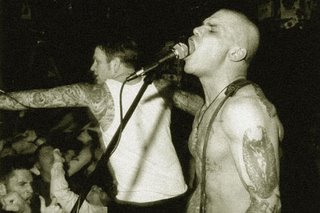PETA: Not the Cuddly Organization You Thought.
This article appears in the Fall 2006 3rd edition of Kutztown University's paper, The Keystone.
Online Here
-----------------------------------------------------------
When you think of PETA, you would usually think of an organization dedicated to animal rights and liberation, not the destruction of animals that were promised good homes. Would you consider “ethical” as supporting arsonists or curbing research and organizations dedicated to finding a cure for AIDS or cancer? No one wants to see animals harmed or destroyed, but where does the line between activism, hypocrisy and pure stupidity blur?
On June 15th of 2005, two members of PETA, Adria Joy Hinkle, described as being the “Mother Teresa of Animals” by PETA’s president, and Andrew Cook, were arrested while dumping the dead bodies of 18 animals into a supermarket dumpster. Both were charged with 31 felony counts of animal cruelty each. The animals – which were euthanized in the back of a PETA van – had been obtained from a
Surely this was an isolated incident involving two rogue members of PETA. Unfortunately, this is not the case. Documents filed by PETA in the state of
One would believe that an organization which has an annual budget of over $20 million would be able to either find homes for these animals or at least board them until they could find homes. This is, after all, the People for the Ethical Treatment of Animals we are talking about. Instead, PETA uses their millions to finance their advertisement, and to buy stocks in such companies as McDonald's, Burger King, Wendy's, Denny's and Tyson Foods. They have also supported terrorist groups such as the Earth Liberation Front, who, together with the Animal Liberation Front, have committed over 600 criminal acts accounting for more than $43 million in damages, according to the FBI. It’s anyone’s guess as to how much they spend on euthanizing all of the animals which they say they protect.

According to their site, PETA believes that human suffering is just as much a problem as non-human suffering, since we are all technically animals. They even state this within their FAQ on PETA.org: There are very serious problems in the world that deserve our attention, and cruelty to animals is one of them. We should try to alleviate suffering wherever we can. Helping animals is not any more or less important than helping human beings—they are both important. Animal suffering and human suffering are interconnected. Why, then, was PETA’s president, Ingrid Newkirk, quoted saying, “…even if animal research resulted in a cure for AIDS, we would be against it.”?
Whether you like it or not, animal research has not only helped human beings in the quest for cures and genetic problems, but without some animal research we would not even be able to save some of our most beloved, four-legged family members in their time of need. To say that suffering throughout the entire animal kingdom is equal whether it is human or non-human suffering, and then attacking such organizations as the March of Dimes, the Pediatric AIDS Foundation and the American Cancer Society because of its research to end human afflictions is complete hypocrisy.
Calling an organization which condones terrorist acts, the euthanization of homeless animals over adoption and promoted the drinking of beer over milk as “drinking smart” to college aged students ethical is beyond unbelievable. If you truly feel for animal rights and liberation, then I suggest you do what you can to raise awareness about such things as vivisection, factory farms, circus abuse and racing greyhound abuse, as well as other such issues, on your own or by forming your own group. Feeding a hypocritical organization, like PETA, does nothing but help them raise more money to push their jilted agenda.



